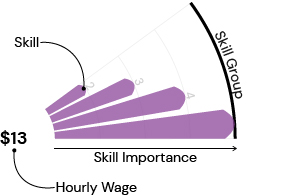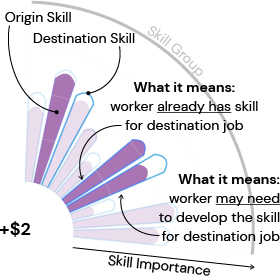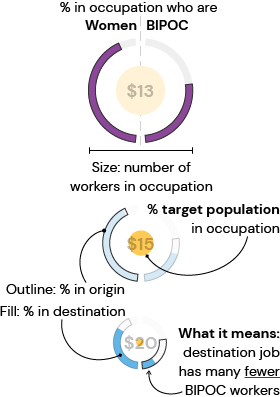Low Wage Does Not Mean Low Skill: Pathways to Mobility for 24 Million Workers Skilled Through Alternative Routes
How to read this visualization


How to read this visualization

How to read this visualization

How to read this visualization






Our analysis of observed labor market transitions paints a compelling picture of pathways that workers can navigate towards higher wages. They also offer insights into where employers can look for skilled talent to fill middle- and high-wage jobs. To provide greater insight into skills-based transitions that offer workers pathways to higher wages, we created the Job Pathways Exploration Tool.
The tool allows you to choose an origin job of interest, using filters to focus on jobs by wage and demographics, and explore three potential pathways for that job. The “most common” pathway shows the five most commonly observed transitions made from the origin job that yield at least a 10% wage increase. The “next best job” shows up to five jobs that are within reach based on the level of skill similarity. These transitions are often less common but have been observed in the labor market and provide a wage gain of at least 25%. Finally, the “stretch job” shows up to five transitions to jobs that yield at least a 50% wage gain. These jobs may require a skilling intervention to achieve them but have been observed with sufficient frequency over the past 10 years to consider them attainable. For each initial job transition, we also show one commonly observed follow-up transition to demonstrate one possible pathway across three jobs. Below the pathways, we provide an illustration of the skillsets and skill overlaps across these jobs.
Our target population of 24 million people is derived from the civilian, non-institutionalized labor force aged 16 or older. These individuals are not currently enrolled in school, have less than a bachelor’s degree, and have family incomes below two times the Federal poverty line. The poverty line for a single individual in 2019 was $13,011.
Information on these workers' employment, demographics, and wages come from the 2019 1-year American Community Survey. Information on the skills needed for a given occupation come from the Occupational Information Network (O*NET) 26.0 Database. The 2011 to 2020 Current Population Survey Annual Social and Economic Supplements provide information on observed year-to-year job transitions over the past 10 years. These sources are combined based on harmonized occupation codes developed by the Minnesota Population Center Integrated Public Use Microdata Series (IPUMS). All wage estimates are in 2019 dollars.
All job transitions shown in this tool offer at least a 10 percent wage increase and have been made by at least 2,000 workers over the past 10 years. We limit transitions to only those where individuals without a bachelor’s degree make up at least 2 percent of workers in both the origin and destination job.
We determine the feasibility of a job transition based on the skill distance across origin and destination jobs. Skills-based transitions are those where the Euclidean distance across the 35 skill dimensions is 2.5 or less, indicating a strong overlap in the importance of skills across jobs. Stretch transitions are defined as transitions that offer higher wage gains (at least 50 percent) but which may require training interventions due to a skill distance of 3.0 or greater.
We identify occupations where our target population is overrepresented if the labor force in that occupation is at least 50 percent higher than in the overall workforce.
We identify Black, Indigenous, People of Color (BIPOC) workers as those who report being non-White, multi-racial, or Hispanic.